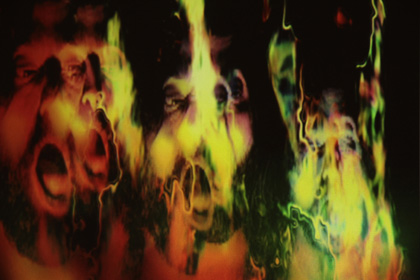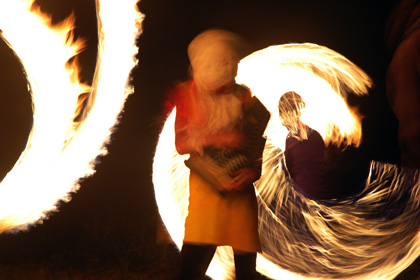DVD
The horrordelica… the horrordelica…
ODDSAC

Animal Collective and Danny Perez’s new visual album crosses hippie pioneer Ira Cohen with horrormeister Alexandre Aja. Sam Davies wonders which way to turn
ODDSAC
Animal Collective & Danny Perez; US 2010; Plexi / Region 0 DVD; 53 mins; Aspect ratio 1.78:1; Features: 40-page hardcover art book in a slipcover case; Dolby 2.0 stereo and 5.1 surround-sound audio tracks
Animal Collective’s last album, Merriweather Post Pavilion, was a fixture on many critical best-of-year lists in 2009. But its follow-up may well be overlooked by many.
Why? Because ODDSAC, produced in collaboration with director Danny Perez, is a visual album, to be released on DVD by Plexi in late July. And the visual album is a form that’s never really caught on. The idea of a longform marriage of film and music has long obsessed a certain kind of multi-media literate musician. Dada art-punks Devo were dreaming of album-film hybrids three decades ago, before MTV was even born. Technology, rather than enabling the concept, seems to have confounded it, the Walkman and then the iPod making music something as likely to be consumed sat on a bus as on a sofa, while YouTube and filesharing have placed the very viability of the album form under threat.
So ODDSAC has a hint of the quixotic about it. But its 54 minutes of sound and vision deserve attention. ODDSAC feels like a genuine collaboration, rather than a desultory soundtracking of a pre-existing film with cast-offs – or a by-numbers exercise in which an album is ‘interpreted’ cinematically. Director Danny Perez describes it as “an open-ended operation of audio-visual synthesis, the passing back and forth of visuals and sound so that each would inform the other and create an organic structure.” And the four years spent on the project suggest this back-and-forth was real.
But ODDSAC also works as a meeting point for particular cinematic undercurrents – a psychedelic tradition running back to 1960s counterculture and to Ira Cohen’s Mylar room mutations in The Invasion of Thunderbolt Pagoda (1970), as well as horror subgenres like Italian giallo, Cronenbergian bodyshock and the verité, on-the-cheap visuals of Herzog, Craven, Lynch and later The Blair Witch Project (1999). The music weaves through Perez’s lurid colours and oddly visceral props in a turbulent stream, one which runs intriguingly counter to Animal Collective’s recent turn towards pop: Beach Boys-style harmonizing and campfire folk are disrupted by disembodied shrieks, pulsating dance rhythms, and blasts of noise.

The film bleeds together roughly eight scenes and eight accompanying tracks (and those Sight & Sound readers who always read the synopsis can find a meticulous map of the film by Mark Beaumont at his Guardian blog). It begins cryptically with a turbaned drummer advancing on a room whose walls bleed oil and, at least initially, it glories in making no sense: figures (often the band members) move through pastoral landscapes radically denatured via toxic colour filters and savage cross-edits. The early scenes build to a colour blizzard, like a detuned television using the full rainbow-colour spectrum.
But from this abstract lull, ODDSAC takes a surprising turn towards narrative, its latter stages following a topknotted vampire who skulks through woodland as if AWOL from the set of Herzog’s Nosferatu (1979). A family roast marshmallows over a campfire and feast on them in a squeamishly gooey orgy, before the vampire attacks. He flees, and the film reaches another crescendo as contact with the sun sees his head spurt steaming gouts of paint.
“We used to score our own imaginary horror films… Southern, dark, swampy, Texas Chain Saw Massacre-style,” bandmember Josh Dibb told UK magazine The Wire last year. Perez is a self-confessed fan of Alexandre Aja (Switchblade Romance, 2003; The Hills Have Eyes, 2006). And this interest in horror is the key to the film. ODDSAC’s dream-like logic both invites and eludes any stable interpretation, drawing comparisons to Matthew Barney’s elliptical Cremaster cycle (1994-2002). But its achievement instead lies in the overlap it insists on between psychedelia and horror: not so much in the nightmare voids of the bad LSD trip, but in the deranged expressionist potential that lies even in stock horror scenarios.
(As well as in its online trailer, a taste of ODDSAC can be found in Perez’s video for Animal Collective’s ‘Summertime Clothes’. A troupe of dancers move through saturated light projections, each encased in a kind of translucent bulb, veined like an organ or egg sac. The play of intense colour, transparency and a Cronenbergian play with the body’s elastic, mutant potential are all comparable.)
ODDSAC is previewed with director Q&As at the ICA London (13 May), Mint Lounge Manchester (14 May), Brudenell Social Club Leeds (15 May) and thenceforth at further venues around Europe. Its DVD and iTunes releases are scheduled for 26 July.
See also
The DVDs of 2009 (online exclusive, December 2009)
A curious faith: Owen Hatherley on Jeremy Deller and Nick Abraham’s Depeche Mode-fan documentary The Posters Came from the Walls (online exclusive, November 2009)
Sonic youths: Sam Davies interviews Jonathan Caouette about All Tomorrow’s Parties (online exclusive, October 2009)
The razor’s edge: Mark Kermode reviews Alexandre Aja’s Switchblade Romance (Film of the Month, October 2004)
The white stuff: Mark Cousins salutes Matthew Barney’s Cremaster cycle (December 2003)
The Blair Witch Project reviewed by Charles Taylor (November 1999)
